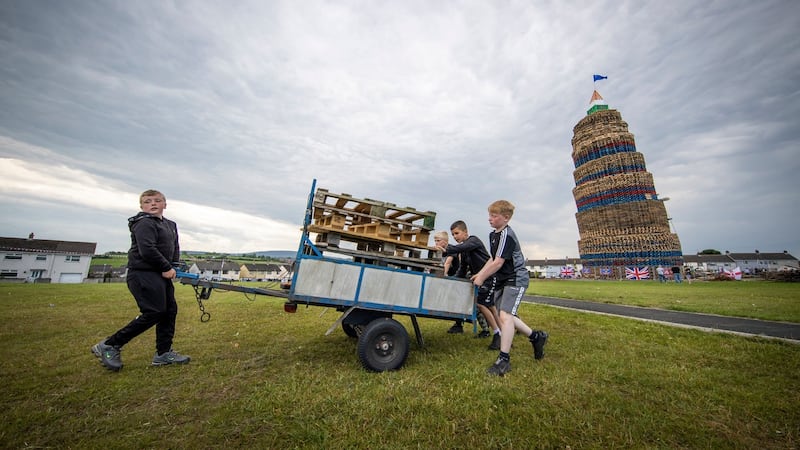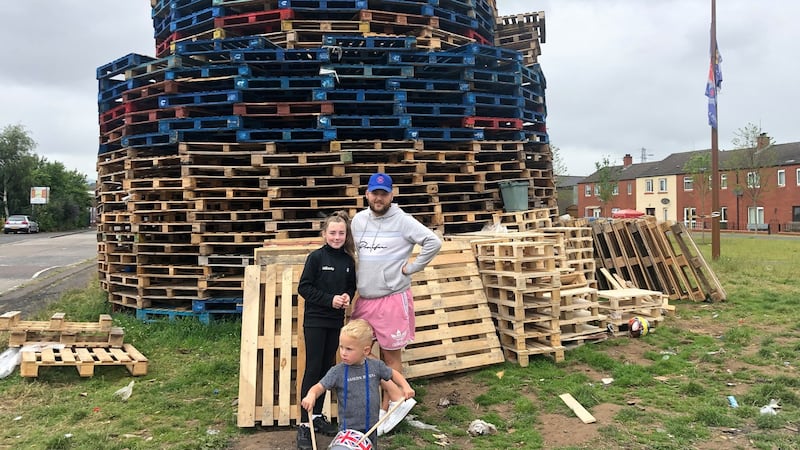Eight-year-old Kai is standing on top of a 40-pallet-tall 11th Night bonfire on Craigyhill outside Larne and is doing the floss dance.
He holds both his arms ridged as he swings them rhythmically, in front of and behind his stomach, to the imagined music in his head. He is pleased as punch when a young mother passing by pauses to take his picture.
“It’s a bonfire,” he tells me, surely wondering at the idiocy of my question, but then tumbles out a pile of further information in the way that children do.

“It’s about King William and the Battle of the Boyne. There was a giant war and people lost lives and all that. I know a lot about war because my great, great grandfather was in the second World War. When he was flying a plane a German bomber bombed him down and they didn’t find his body because it was blown to bits.”
Across the other side of what locals in this vast housing estate call simply The Big Green, a group of men, among them Colin, Andy, Jackie, Alan, Robert and Big Bob, are lounging on discarded couches set randomly among the detritus of the other bonfire – the tallest bonfire, by a country mile, in all of Northern Ireland.
It is ready for Sunday’s 11th Night festivities to usher in another 12th of July proclaiming of all things Orange. But it is so high and so unstable that several ratchet ties of the sort used to secure loads on the backs of lorries have been lashed on to it in the hope of holding it in place.
“That there’s 16,000 pallets,” says Big Bob, who is indeed big and is munching his way through a packet of crisps. “How high? I’ll tell you how high. That there’s 147 feet.”
I introduce myself and ask Big Bob his surname.
“Big Bob No Comment,” he says smiling, as his mates repeat their membership of the “no comment” family. They are all brothers-in-arms and in their welcoming of me, they offer beer and chocolate-covered Swiss roll.
The pallets cost about £20,000 (€23,000) – about £1 for the untreated wood and up to £10 for the heavy-duty, blue- or red-painted ones, though Bob insists that the £20,000 also pays for what will be a big fun day for local children as well.

All around the green, but especially along the fence behind one row of homes, flags and posters celebrate loyalist militarism. Craigyhill Battalion UDA, says one. Ulster Freedom Fighters, says another.
A fence around the giant bonfire has also been decked out with union flags, Northern Ireland centenary flags and others celebrating, in one form or another, the proud links between Northern Ireland’s Protestant community and the British army.
There are no political posters on the pyre, but the top is capped by a sort of square box, coloured green, white and orange. The sides of it say protocol with an X through it, Brexit and, somewhat oddly, with an X through it, IRA, and “F**k the PSNIRA”.
And topping everything off is the blue Starry Plough flag, not the European Union flag as has been claimed on social media.
"Why's that there?" Bob says to Alan, repeating my question as Alan tries to swallow a mouthful of pie and therefore cannot answer. "That there's the flag of the INLA [Irish National Liberation Army]. There's a lot of them in Carnlough, " says Bob of the village a little further along the Antrim coast.
The lads are hanging around to keep an eye on the giant bonfire, so that no one gets too close to it, either to admire it or damage it or, maybe, to set it alight too early.
“Last week, there was a £1,000 bounty because of all the publicity we’ve had,” says Bob. “At the minute, it’s a £10,000 bounty. That’s from the nationalists. That’s why we’re here, protecting our identity.”
Alan, his luncheon concluded, gives me a tour of the base of the bonfire and talks me through the various flags. We look at the stays and, from the other side, the precarious lean of the tower.
“Aye, she’s hold up alright,” he says confidently even as squashed pallets creak audibly because of the massive weight above them.
Most of the people in Craigyhill have jobs, says Alan, and the place certainly looks prosperous compared with loyalist strongholds in inner city Belfast where bonfires are numerous, though much smaller.

At Protestant Pitt Park on the Lower Newtownards Road, separated from the nearby Catholic Short Strand, a middle-aged woman, a man who could be her son and a young girl, possibly a grand-daughter, watch from their small home on Harland Drive as workmen clear the debris of a prematurely lit bonfire, which was sited in a small park immediately across the road from St Matthew's Catholic church.
“The kids worked hard, they really did,” says the woman, lamenting its destruction while explaining, somewhat unconvincingly, that her name is Eileen. “But they’ll rebuild it,” she adds.
Who set it off, I wondered out loud.
“They say it’s Catholics that did. But they didn’t, there’s no evidence of that,” she says.
“Eileen” is all for good relations with her near neighbours and she wants education integrated as well.
“See here,” says the younger man, “at any other time of the year, the boys [from Pitt Park] are over there,” he indicates towards St Matthew’s and the Short Strand, “kissing the girls.”
Eileen urges a visit up the road to Tamar Street where the bonfire remains unmolested. There, there are more people who are content to talk, but not to be identified.
A young man in pink shorts, Stephen Hunter, a cheeky, smiling girl named Miley Smith (11), and Jax Hunter (3) are all hanging out, making sure no one tosses a stray match on to their 60-pallet-tall bonfire.
Jax has a tiny Union Jack-painted tin drum that he attempts to bang as he wanders about the wasteland – a dystopian mess of used and unused warehouses and far from well-off homes. Stephen does a convincing twirl and throw of Miley’s marching baton.
The younger man, who had earlier wanted to take my motorbike for a ride, and I talk about motorbikes and I ask him what’s the bonfire all about.
“Just celebrating our culture,” he says, “and getting blocked. That’s basically it.”
Blocked means drunk.










